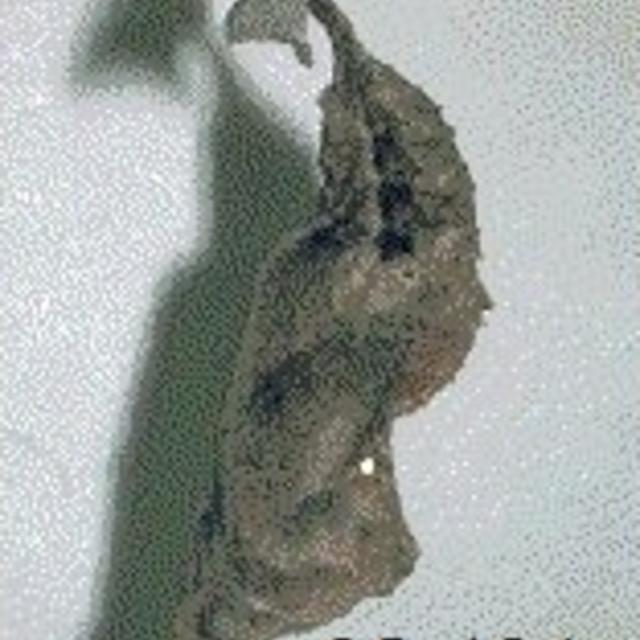National Moth Week is July 20-28, 2024!
Moths are amazing creatures. Take photographs and share your moth sightings with us to document the moths where you live.
Oreas Comma
Polygonia oreas (W.H. Edwards, 1869)
Family: Nymphalidae
Subfamily: Nymphalinae
Identification: Upperside is red-brown with dark, distinct borders and yellow, chevron-shaped submarginal spots. Underside is blackish-gray; silver mark at center of hindwing is L-shaped.
Wing Span: 1 5/8 - 1 7/8 inches (4.2 - 4.8 cm).
Life History: Males perch on shrubs in valley bottoms during the afternoons to wait for females. Eggs are laid singly under host plant leaves; caterpillars eat leaves and rest under them or on stems. Adults hibernate.
Flight: Overwintered adults emerge in May, mate, and lay eggs of the next generation, which flies from June-October.
Caterpillar Hosts: Gooseberries (Ribes species); perhaps others.
Adult Food: Tree sap, rotting fruit, rarely flower nectar.
Habitat: Coastal canyons, streamsides, redwood forests.
Range: British Columbia south through eastern Washington and eastern Oregon and along the Pacific Slope to central California; southeast through the northern Rockies to southern Wyoming, Colorado, and Utah.
Conservation: Not thought to be of concern.
NCGR: G5 - Demonstrably secure globally, though it may be quite rare in parts of its range, especially at the periphery.
Management Needs: None reported.
Comments: NULL
Get your BAMONA Gear!
Please donate!
We depend on donations to keep Butterflies and Moths of North America freely available. We want to express our gratitude to all who showed their support by making a contribution this year. You can donate to support this project at any time.
Advertise with us!
Do you have a product or service that you think would interest BAMONA users? If you would like to advertise on this website, contact us by email, or use the contact form and select the "Advertising" category.
Verified Sightings
Displaying 1 - 24 of 137 verified sightings

Observation date: Apr 21, 2024
Submitted by: icosahedron
Region: San Mateo County, California, United States
Verified by: Ken Davenport
Verified date: Jun 19, 2024

Observation date: May 19, 2024
Submitted by: TomPeterson
Region: Santa Clara County, California, United States
Verified by: Ken Davenport
Verified date: Jun 06, 2024

Observation date: Apr 22, 2024
Submitted by: glennfine
Region: Siskiyou County, California, United States
Verified by: Ken Davenport
Verified date: Apr 23, 2024

Observation date: Apr 09, 2024
Submitted by: glennfine
Region: Siskiyou County, California, United States
Verified by: Ken Davenport
Verified date: Apr 23, 2024

Observation date: Apr 21, 2024
Submitted by: TomPeterson
Region: San Mateo County, California, United States
Verified by: Ken Davenport
Verified date: Apr 22, 2024

Observation date: Apr 12, 2024
Submitted by: weflybye
Region: Mason County, Washington, United States
Verified by: davidwdroppers
Verified date: Apr 16, 2024

Observation date: Aug 02, 2023
Submitted by: Thom Garrett
Region: Missoula County, Montana, United States
Verified by: J_Martineau
Verified date: Aug 07, 2023

Observation date: Aug 02, 2023
Submitted by: weflybye
Region: Mason County, Washington, United States
Verified by: davidwdroppers
Verified date: Aug 03, 2023

Observation date: Jul 09, 2023
Submitted by: neilpa
Region: King County, Washington, United States
Verified by: davidwdroppers
Verified date: Jul 27, 2023

Observation date: Jul 13, 2023
Submitted by: hiker96
Region: Mason County, Washington, United States
Verified by: davidwdroppers
Verified date: Jul 16, 2023

Observation date: Apr 29, 2023
Submitted by: weflybye
Region: Clallam County, Washington, United States
Verified by: davidwdroppers
Verified date: May 01, 2023

Observation date: Apr 28, 2023
Submitted by: weflybye
Region: Mason County, Washington, United States
Verified by: davidwdroppers
Verified date: Apr 28, 2023

Observation date: Apr 16, 2023
Submitted by: Thom Garrett
Region: Missoula County, Montana, United States
Verified by: stevekohler
Verified date: Apr 24, 2023

Observation date: Jun 20, 2021
Submitted by: CreekyCedars
Region: British Columbia, Canada
Verified by: Paul Prappas
Verified date: Sep 07, 2022

Observation date: Apr 30, 2022
Submitted by: Theovenbird
Region: British Columbia, Canada
Verified by: Paul Prappas
Verified date: Sep 07, 2022

Observation date: Aug 10, 2021
Submitted by: sandyleapt
Region: Benton County, Oregon, United States
Verified by: Ken Davenport
Verified date: Jul 27, 2022

Observation date: Jul 24, 2022
Submitted by: sfbaywildlife
Region: San Mateo County, California, United States
Verified by: Ken Davenport
Verified date: Jul 25, 2022

Observation date: Jul 19, 2022
Submitted by: icosahedron
Region: San Mateo County, California, United States
Verified by: Ken Davenport
Verified date: Jul 24, 2022

Observation date: Apr 08, 2022
Submitted by: glennfine
Region: Siskiyou County, California, United States
Verified by: Ken Davenport
Verified date: Apr 11, 2022

Observation date: Apr 06, 2022
Submitted by: hiker96
Region: Mason County, Washington, United States
Verified by: davidwdroppers
Verified date: Apr 08, 2022

Observation date: Mar 30, 2022
Submitted by: weflybye
Region: Mason County, Washington, United States
Verified by: davidwdroppers
Verified date: Mar 30, 2022

Observation date: Aug 12, 2015
Submitted by: brandy maclennan
Region: Alberta, Canada
Verified by: jwileyrains
Verified date: Jan 29, 2022

Observation date: Jun 05, 2021
Submitted by: Christian.Nunes
Region: Douglas County, Colorado, United States
Verified by: mikefisher
Verified date: Dec 05, 2021

Observation date: Jun 12, 2018
Submitted by: Mark Salvato
Region: Monterey County, California, United States
Verified by: Ken Davenport
Verified date: Oct 11, 2021
- 1 of 6
- next ›





